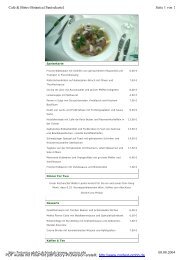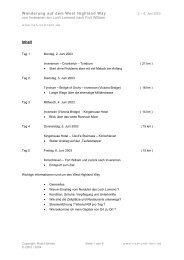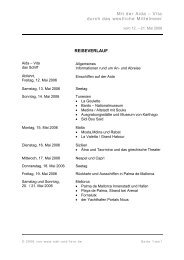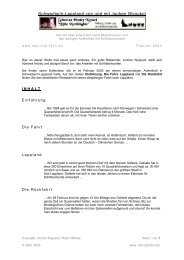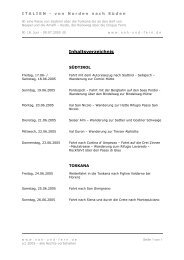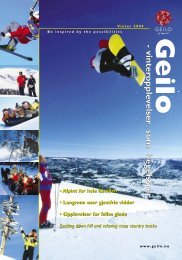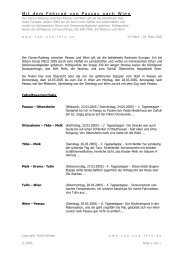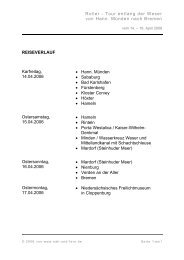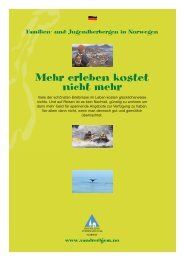TREKKING INFORMATION SHEET - nah-und-fern.de
TREKKING INFORMATION SHEET - nah-und-fern.de
TREKKING INFORMATION SHEET - nah-und-fern.de
Create successful ePaper yourself
Turn your PDF publications into a flip-book with our unique Google optimized e-Paper software.
<strong>TREKKING</strong> <strong>INFORMATION</strong> <strong>SHEET</strong><br />
Flin<strong>de</strong>rs Chase Coastal Trek<br />
Flin<strong>de</strong>rs Chase National Park and Ravine <strong>de</strong>s Casoars Wil<strong>de</strong>rness Protection Area, Kangaroo Island<br />
Trekking in Flin<strong>de</strong>rs Chase National Park and Ravine <strong>de</strong>s<br />
Casoars Wil<strong>de</strong>rness Protection Area<br />
Kangaroo Island's rugged coastline offers keen<br />
bushwalkers spectacular coastal scenery, pristine rivers,<br />
tracts of <strong>und</strong>isturbed native vegetation and opportunities<br />
to observe ab<strong>und</strong>ant and diverse wildlife. Most of the<br />
coast is very isolated and provi<strong>de</strong>s walkers with a true<br />
wil<strong>de</strong>rness experience. However, this isolation also means<br />
that good planning is essential to ensure that your walk is<br />
as enjoyable and safe as possible.<br />
This leaflet is <strong>de</strong>signed to help you plan your walk by<br />
providing information on where to camp, where to get<br />
water, the distances involved, and what you need to do<br />
before you begin your trek. The information relates to the<br />
coastal areas between Cape du Couedic on the south<br />
coast and Harvey's Return on the north west coast,<br />
including Maupertuis Bay, West Bay, Ravine <strong>de</strong>s Casoars<br />
and Cape Borda. (Trekking in other areas not permitted).<br />
DISTANCES OF SECTIONS<br />
Section of Trek<br />
Distance<br />
1. CAPE DU COUEDIC TO SNAKE LAGOON 16 km<br />
Cape du Couedic to Rocky River Mouth<br />
Rocky River Mouth to Snake Lagoon (via<br />
walking trail)<br />
14 km<br />
2 km<br />
2. SNAKE LAGOON TO WEST BAY 20 km<br />
Snake Lagoon to Sandy Creek<br />
Sandy Creek to Breakneck River<br />
Breakneck River to West Bay<br />
5 km<br />
8 km<br />
7 km<br />
3. WEST BASY TO RAVINE DES CASOARS 18 km<br />
West Bay to Ravine <strong>de</strong>s Casoars Car Park<br />
- via coast 15 km then walking trail 3 km<br />
OR<br />
- via road 2 km then fire track 16 km<br />
OTHER DISTANCES<br />
Ravine <strong>de</strong>s Casoars Car Park to Harveys<br />
Return Campgro<strong>und</strong> (via road)<br />
Harveys Return Campgro<strong>und</strong> to Cape<br />
Borda Lightstation (via walking trail)<br />
Maps<br />
18 km<br />
10 km<br />
4.5 km<br />
You should carry the appropriate 1:50 000 topographical<br />
maps to walk Kangaroo Island’s remote coastline. BORDA<br />
sheet covers Harvey’s Return, Cape Borda and Ravine<br />
<strong>de</strong>s Casoars; and VENNACHAR sheet covers West Bay to<br />
Cape du Couedic.<br />
Minimum Impact Bushwalking<br />
To minimise your impact on this wil<strong>de</strong>rness area, please<br />
adhere to the Minimum Impact Bushwalking brochure<br />
gui<strong>de</strong>lines.<br />
Access<br />
One of the major obstacles to overcome is that trekking the<br />
coast does not allow for easy loop-walks, and it can be<br />
difficult to get back to your car without backtracking or<br />
using roads. To do a one-way trek you will need a vehicle<br />
at your start and finish points. If you only have one vehicle<br />
and wish to do an overnight loop trek, we recommend you<br />
trek from Ravine <strong>de</strong>s Casoars to West Bay via coast, and<br />
return via the road/fire track the following day (18 km each<br />
way). Harveys Return Campgro<strong>und</strong> is i<strong>de</strong>ally located for<br />
camping the night before and the night you finish your trek<br />
(bookings required for all campgro<strong>und</strong>s).<br />
The Route<br />
The trek can begin at either end or be accessed from a<br />
number of locations using existing walking trails and roads.<br />
It is usually walked in 3 sections: Cape du Couedic to Snake<br />
Lagoon; Snake Lagoon to West Bay; West bay to Ravine<br />
<strong>de</strong>s Casoars car park. Experienced bushwalkers may<br />
choose to complete the entire trek, while people with an<br />
average fitness level can <strong>und</strong>ertake shorter routes.<br />
When to walk<br />
Kangaroo Island's weather is generally mil<strong>de</strong>r than the<br />
mainland with cooler summers, and fine weather is not<br />
uncommon during winter. The best weather for walking<br />
occurs during spring and autumn, and long periods of fine<br />
and mild weather can occur in these seasons. During<br />
summer, temperatures on the cliff-tops can be extreme,<br />
and in winter cold fronts roar in straight off the Southern<br />
Ocean creating very poor conditions for walking. Both of<br />
these extremes represent potentially dangerous situations<br />
and must be carefully consi<strong>de</strong>red when planning your trip.<br />
During the warmer months you must carry ample water,<br />
along with sunscreen and a hat, and in the cooler months<br />
warm clothing and rain jackets are essential. As a general<br />
rule, because weather can be so unpredictable, expect<br />
the unexpected and be prepared!<br />
Campsites<br />
Where possible, please plan your trek aro<strong>und</strong> existing<br />
campgro<strong>und</strong>s (Snake Lagoon, West Bay and Harveys<br />
Return) to minimise your environmental impact. Bookings<br />
are required for all campgro<strong>und</strong>s.<br />
Revised: April 2004
Water<br />
Water can be very limited and it is crucial that you plan<br />
your trek aro<strong>und</strong> water supplies. Several rivers along the<br />
route flow to the coast in most winters and early spring.<br />
Water should be treated prior to consumption. Rainwater<br />
tanks are located at Snake Lagoon, West bay and<br />
Harveys Return campgro<strong>und</strong>s, however water supply<br />
cannot be guaranteed and water should be treated prior<br />
to use.<br />
Fires<br />
Please note that this trek is a fuel stove only route (except<br />
on days of Total Fire Ban).<br />
Heritage Accommodation<br />
Looking for a comfortable way to start or end your trek?<br />
Various types of heritage accommodation, including<br />
lightkeepers cottages and backpackers huts are<br />
available at Cape Borda, Cape Du Couedic and Rocky<br />
River (book through Flin<strong>de</strong>rs Chase Visitor Centre).<br />
Fungus Alert<br />
Phytophthora cinnamomi or Cinnamon Fungus is a disease<br />
that kills many native plants and <strong>de</strong>stroys vital wildlife<br />
habitats. It is wi<strong>de</strong>spread on Kangaroo Island and your help<br />
is required to halt its spread. Bushwalkers can spread the<br />
fungus in soil sticking to their boots, tent pegs and toilet<br />
trowels. Make sure you start your trek and leave each<br />
campsite with clean gear and remove soil from your boots<br />
before leaving an area.<br />
Bush Trekking Registration<br />
• Before your trek commences you MUST complete a Trip<br />
Intentions form and post or fax it back to Flin<strong>de</strong>rs Chase<br />
National Park. Once you have completed the form<br />
please contact Flin<strong>de</strong>rs Chase, as your proposed route<br />
must be discussed with a Ranger.<br />
• There is a daily fee for bush trekking which covers<br />
camping and a per person entry fee to the park, which<br />
are to be paid in advance at Flin<strong>de</strong>rs Chase Visitor<br />
Centre.<br />
• You should leave a copy of your itinerary with a<br />
responsible person. They should contact Police if you<br />
have not logged out with them by a pre-arranged<br />
date and time.<br />
Wildlife – Observe, don’t interact<br />
Every season presents fantastic opportunities to view<br />
wildlife on western Kangaroo Island. Trekkers in remote<br />
coastal areas are often rewar<strong>de</strong>d with sightings of whales,<br />
ospreys, seals and sea-eagles. Mallee and woodland areas<br />
provi<strong>de</strong> a home for ab<strong>und</strong>ant birds, goannas and<br />
mammals such as echidnas and kangaroos.<br />
For your personal safety and for the protection of the<br />
animals, always use the following Wildlife Watching<br />
Gui<strong>de</strong>lines:<br />
• Stay on the trail<br />
• Put the animals welfare first<br />
• Move slowly and quietly<br />
• Observe from a distance<br />
• Use binoculars for the close–up view<br />
Failure to do so will cause unnecessary disturbance and<br />
stress, particularly for seal colonies and coastal raptors.<br />
Please remember that all plants, animals and natural<br />
features in parks and wil<strong>de</strong>rness areas are protected.<br />
Feedback<br />
KEEP WILDLIFE WILD<br />
Please do not feed the animals<br />
Please help us to make the trek safe and enjoyable for<br />
other trekkers. If there is anything you would like to bring to<br />
our attention, please fill in a feedback Information Sheet at<br />
DEH office on Kangaroo Island.<br />
Department for Environment and Heritage<br />
Flin<strong>de</strong>rs Chase National Park<br />
PMB 246, Kingscote SA 5223<br />
Telephone: (08) 8559 7220<br />
Facsimile: (08) 8559 7268<br />
Visitor Centre: (08) 8559 7235 for camping &<br />
accommodation bookings



